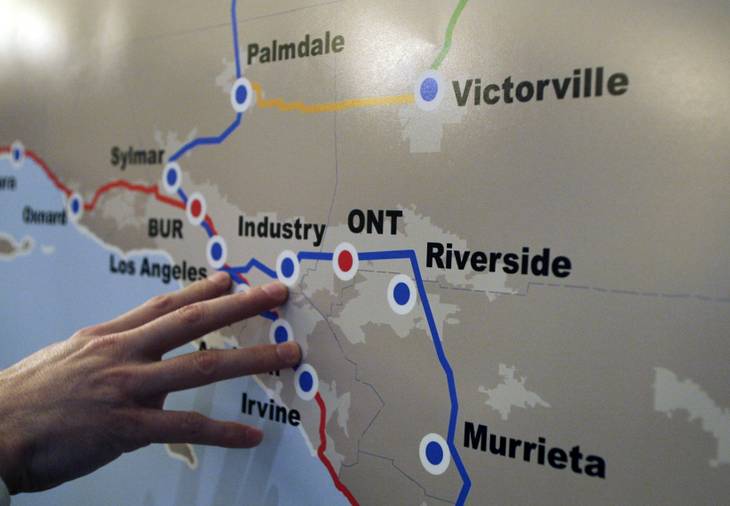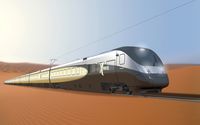A seamless high-speed rail system linking Las Vegas with downtown Los Angeles is the goal adopted today by representatives of DesertXpress and the Los Angeles Metropolitan Transit Authority.
DesertXpress Enterprises already is trying to build a high-speed rail line between Las Vegas and Victorville, Calif. A new agreement signed today makes possible a second leg, linking Victorville to Palmdale, Calif., and eventually Los Angeles.
DesertXpress and MTA representatives signed documents that open the door to the Las Vegas-Los Angeles route. The agreement includes a strategy to plan and build a 50-mile high-speed line between Victorville and Palmdale, which would initially connect to Metrolink tracks and eventually be the connection point to California’s planned high-speed rail system.
The DesertXpress plan is part of a larger strategy envisioned by the Las Vegas-centered Western High Speed Rail Alliance to eventually tie into a regional high-speed rail network with routes to Phoenix, Salt Lake City and Denver.
Letters were signed by Tony Marnell II, founder, chairman and CEO of the Marnell Companies LLC, a partner in the DesertXpress project, and Los Angeles County Supervisor Michael Antonovich, the incoming chairman of the MTA board.
“We really need to move forward on this,” Antonovich said. “I’m frustrated that the United States spends billions of dollars in foreign aid that ends up in the pockets of third-world dictators. This project is a loan, so the money is being paid back and it keeps it in the United States and benefits American citizens.”
While developers have several hurdles to clear and hundreds of details to outline, the plan has been hailed as a potential game-changer for transportation between Southern California and Southern Nevada because it addresses the biggest flaw in DesertXpress’ original plan -– the use of Victorville as a southern end point to the route.
Critics have blasted DesertXpress as a multibillion-dollar boondoggle. Many doubted the company's premise that people would drive 100 miles or more to Victorville and park their cars to take a 150-mph, 1½-hour train ride to Las Vegas.
DesertXpress officials argued that the Las Vegas tourism experience would begin upon boarding the train in California, and passengers would be able to confirm hotel reservations and make dinner and show plans en route.
Antonovich, who plans to go to Washington to brief Transportation Secretary Ray LaHood about the plan next week, said working with DesertXpress makes sense because the company and MTA have a mutual need to move passengers between Victorville and Palmdale. Thousands of L.A. commuters live in Victorville and its surrounding communities and would benefit from a rail connection to the city.
Work began in 2010 on getting environmental clearances for a 500-foot right of way between Victorville and Palmdale for the so-called High Desert Corridor, a freeway that would provide an alternate route from the West Coast to inland ports. Antonovich said the rail line would be placed within that right of way.
Several communities have endorsed the link through the High Desert Corridor Joint Powers Authority. The counties of Los Angeles and San Bernardino, the cities of Victorville, Palmdale, Lancaster and Adelanto and the town of Apple Valley back the plan.
Antonovich said the connection would support a system that would extend the MTA’s Metrolink operation from Victorville to San Diego.
The Federal Railroad Administration, which is considering a loan for the project through its Railroad Rehabilitation and Improvement Financing program, is expected to view the strategic change favorably. DesertXpress submitted the loan request more than a year ago.
Earlier this week, FRA administrator Joseph Szabo said while addressing a press conference at the American Public Transportation Association rail conference in Dallas that he could not comment or give updates on DesertXpress's pending loan application.
The 185-mile, double-tracked Las Vegas-Victorville section of the line, the company's engines and passenger cars and train stations would cost an estimated $6.9 billion.
The FRA loan program, dedicated to funding the development of new railroads or intermodal facilities, the acquisition, improvement or rehabilitation of rail equipment or facilities and the refinancing of debt for rail projects, has the capacity to loan up to $35 billion to projects. About $33 billion of that money is available now.
The DesertXpress loan would be the largest in the program’s history. It would have an interest rate equivalent to the yield of U.S. Treasury securities and a 35-year term.
Developers would put up $1.4 billion in private capital, and government funds would not be used to operate the project.
There’s no estimate yet on the cost of the Victorville-Palmdale link or the improvements necessary on the Metrolink line south of Palmdale.
Andrew Mack, chief operating officer of DesertXpress, said it’s difficult to pinpoint cost and timetable details because officials have just begun talking about them. However, early projections are that the Victorville-Palmdale link would cost around $1.5 billion and that the environmental work would take at least until the end of 2013 to complete.
Work could continue on the Victorville-Palmdale link simultaneously with construction on the Las Vegas-Victorville section.
The Metrolink lines south of Palmdale would need to be electrified with double and triple tracks. Rail experts say the existing lines are capable of accommodating trains that travel up to 50 mph, but the goal would be to have trains that could reach 150 mph.
Antonovich, a Republican, has been one of the leading advocates for rail in Southern California at a time when many Californians are getting cold feet about the $68 billion rail system that has been approved in their state. As vice chairman, he aired the high-speed rail measures with the MTA board. In July, when he takes over as chairman, he’ll bring the proposed partnership with DesertXpress to the board.
A USC Dornsife-Los Angeles Times survey published last week found that 55 percent of the California’s voters want the bond issue for the system that was approved in 2008 back on the ballot, and 59 percent would vote against it.
DesertXpress officials hope to change perceptions by re-emphasizing the safety, environmental and employment benefits of train travel. The company has hired R&R Partners, the Las Vegas-based advertising and public relations firm used by the Las Vegas Convention and Visitors Authority, to update the train system’s messaging.
R&R Partners has begun hyping the fact that the train would use exclusive double track that it wouldn't share with freight carriers and the line would include no grade crossings, reducing the possibility of collisions.
Officials anticipate the train would divert 2 million car trips from congested Interstate 15 a year, reducing traffic by an estimated 25 percent. The all-electric operation of the train is expected to reduce emissions by 40 percent along the I-15 corridor and save the equivalent of 8.5 million gallons of gasoline.
Construction of the train line is expected to generate 80,000 primary and secondary jobs. Most of the jobs would be in California because that's where most of the track would be located.
And while many experts have said one of the biggest challenges in building passenger train ridership would be to pry Californians out of their cars, the American Public Transportation Association said earlier this week that higher gasoline prices have driven auto use down and train travel up.
Szabo said there are 44 rail projects in 16 states that are under way or set to break ground. He added that Generation X and Generation Y consumers consider it a “badge of honor” not to own a car and to rely on mass transit or bicycle sharing programs.

